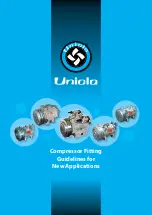
The Utile Engineering Co. Ltd.
28/07/04
Irthlingborough, Northamptonshire. England
Tel: +44 (0) 1933 650216
Fax: +44 (0) 1933 652738
12
IC101
2.
Blade Inspection
When carrying out any maintenance and inspections always follow the health and safety guidelines on page 4.
Ensure all electric circuits are isolated and cannot be switched on, and that the pipeline system has been cleared
and is pressurised to atmospheric pressure. Fully trained and competent service personnel must carry out any
maintenance work.
Inspection commences with the dismantling of the rear end, after removal of the oil tank and pipes.
2.1
Undo screws (29) and remove oil pump (27) complete with coupling (32). Taking care not to damage the oil
pump gasket (28).
2.2
Remove three screws (22) and take off end cap (5) complete with oil pump seals (30) and felt seal (31).
2.3
The thrust washer (15) can now be removed from the bore. Remove four screws (20) and tap off
coverplate (3) complete with bearing seal (14) and outer race of roller bearing (11).
2.4
Measure and note the thickness of the gasket (24) fitted between the cylinder (1) and coverplate (3).
2.5
The blades (7) can now be removed form their slots for inspection.
Check the blades for lamination, chipping or charring on their rubbing edges and for concave wear. For any
other wear other than polished surfaces or if the blade depth has reduced to 24mm or below then replace
the blades.
When replacing blades a complete set must be replaced. The old blades must be disposed of according to
the local government laws. When fitting new blades, make sure they slide freely in their slots and if
necessary remove high spots with fine emery cloth. Lightly smear blade surfaces with oil before
reassembly.
2.6
Inspect the visible part of the cylinder bore and rotor for any signs of excessive wear or scuffing and for
excessive slot wear. If there is any sign of cylinder rubbing completely dismantle the machine. Factory
reconditioning is recommended, but if work has to be carried out on site, we advise you most strongly to
contact Utile Engineering Service Department for advice.
During inspection, determine if the correct oil is being used. Bearings, cylinder wall, rotor/shaft assembly
and blades should show a polished surface with a light film of oil. Hard baked deposits indicate inferior oil,
dirt or excessive temperature.
3.
Reassembly after Blade Inspection
Reassemble in the reverse order, taking note of the following points: -
3.1
Ensure the blades are orientated correctly in their slots.
3.2
If coverplate gaskets have been replaced, it is essential that they are the same thickness as the originals,
otherwise internal clearances will be affected and could cause serious damage. Lightly smear the gasket
with oil before replacing.
3.3
Replace coverplate, screws, thrust washer, end cap and oil pump with coupling. Before reconnecting oil
pipes ensure they are primed.
4.
Cylinder Renewal
With the rear end coverplate (3) already removed as described in 2 for blade inspection, the next stage is to
withdraw the rotor complete with the drive end coverplate (2).
4.1
Remove any oil pipes connected to the drive end.
4.2
Undo 4 screws (20) and slide off the coverplate (2) complete with the rotor.
4.3
Measure and note the thickness of the gasket (24) fitted between the cylinder (1) and coverplate (2).
The cylinder can now be replaced or rebored.
4.4
When reboring the cylinder the maximum allowable increase in diameter is 0.8mm to give a final bore of
102.40mm. Contact Utile Engineering for appropriate assembly instructions in this case.
5.
Removal of Bearings and Seals
With the rear end coverplate (3) already removed as described in 2 for blade inspection.
5.1
Remove circlip (19) then using a two-leg pulley drawer the roller bearing inner race (14) can be removed
from the shaft.
5.2
Should the seal sleeve (8) show signs of wear, then it can be removed by careful machining.
5.3
The bearing seal (14) and roller bearing outer race (11) can be pressed out of the coverplate for inspection.
Blade Inspection, Reassembly after
Blade Inspection, Cylinder Renewal,
Change Bearings and Seals


































